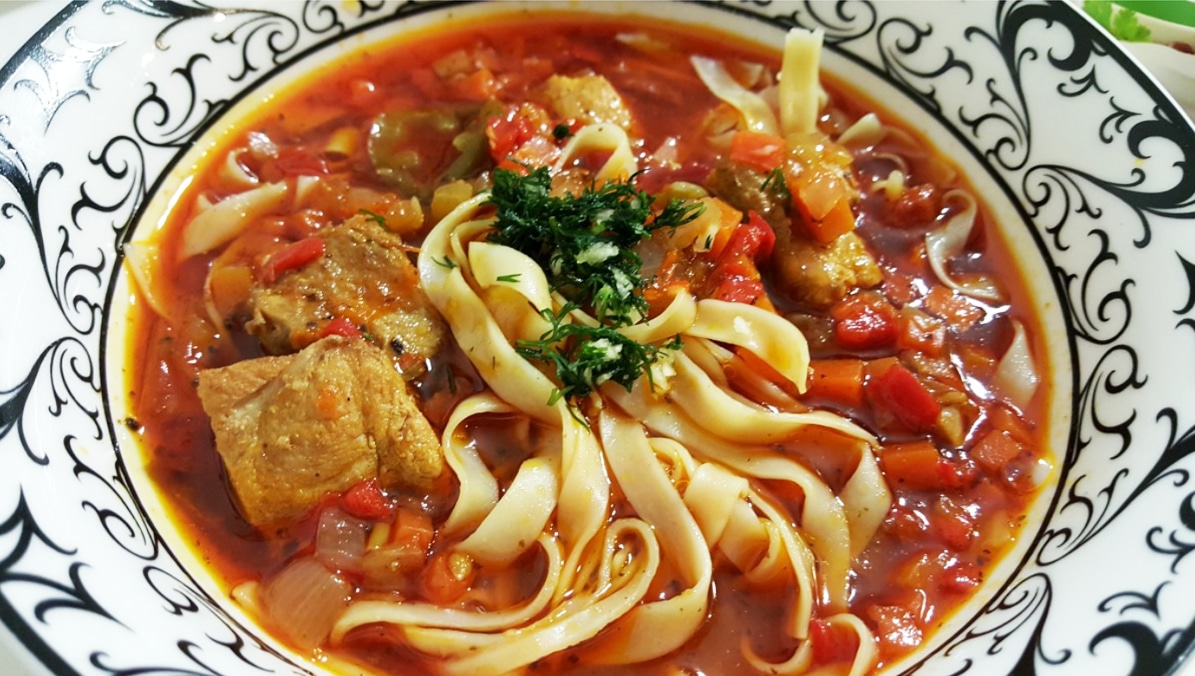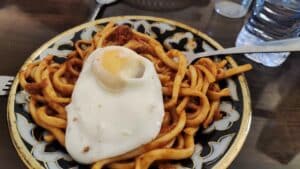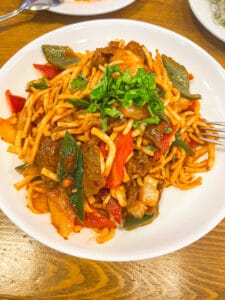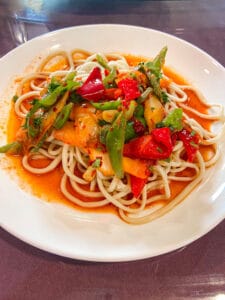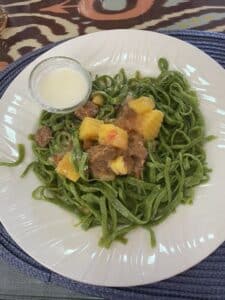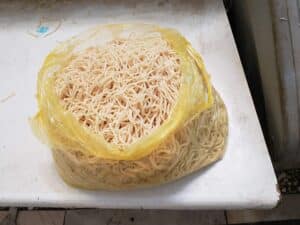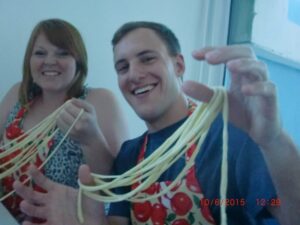Lagman is a dish that is very common in Central Asia, China, and many Middle Eastern countries. It can also be found in Russia and the Caucasus and is a popular dish among the Crimean Tatars. The basic recipe, which combines noodles with meat, has hundreds of variations. In Uzbekistan, the dish tends be a plate of noodles with a thick tomato-based sauce atop it, with meat, vegetables, and often a fried egg. In Kyrgyzstan, on the other hand, the dish is more commonly a soup, with the noodles, meat, and vegetables served in a rich broth. Tadzhik lagman sets itself apart by a particularly wide array of ingredients, which can include unique additions like green beans, kidney beans, chick peas, and radish.
While there are recognized national versions, there are also local versions. Many “national” versions are also found and enjoyed in other countries, meaning that the dish is truly a regional phenomenon.
How Lagman Got Its Name: A Critical History
Thought to have first appeared in what is now China, lagman most likely came to Central Asia via the Uighur and Dungan (Hui) peoples. These largely Muslim minorities of China became part of the Central Asian community over time thanks to religious ties with Central Asia and the economic draw of participation in the Silk Road trade routes. These routes ran through Central Asia and the Caucasus. The dish spread to Persia and Russia as those empires conquered the area.
The name lagman comes from a modification of the Dungan word “lyuman,” which literally means “stretched out dough.” The name is likely even older than that, however, and likely has wide cultural connections. The Chinese, for instance, have a dish made of wheat noodles called “lamian” and the Greeks had a pasta dish called “laganon.” That name lives on in English as the source of the word “lasagne.” In short, pasta, as a high-calorie food with a long shelf life, likely spread like wildfire through human populations once it was invented – fast enough that the original name was kept largely intact as it was transferred between cultures and languages.
Some in the Middle East consider the dish to have developed in the Persian Empire and then spread from there. The Persians called the dish “laksa.” In Old Persian, this word meant “slippery” and is thought to have referred to the texture of the noodles. The Russian word for “noodles,” incidentally, is “lapsha” (лапша), and is derived from the Persian term.
Proponents of a Persian origin often point to the map of the Persian Empire at its height and its rough correspondence to the spread of lagman. Seafaring Persian traders also likely introduced the dish to south east Asia, where it took on multiple unique forms, and is to this day widely knwon . This might be explained, but also may have come from nearby Chinese influence. The Chinese themselves may well have adopted the dish from the Uighurs or Dungans (Hui). The oldest archeological evidence of dumplings, another dough-and-meat dish, has been found in what is now regarded as the Uighur homeland.
Such disputes about ancient artifacts are common, especially with subjects such as food, which can have a large and timeless impact on identity. Culinary historians, however, should be careful to note that while imperial cultures often bequeathed cultural artifacts and traditions to the peoples they conquered, they also absorbed and assimilated culture from those same peoples (and then later bequeathed it to others as their own). A particularly vibrant debate concerning this exists around baklava, for instance.
How and When Lagman is Eaten: Cultural Significance
Lagman, a simple, filling, and flexible dish, is a staple of diets and commonly eaten across Central Asia and China. Easily made in large quantities, it is also commonly eaten for special occasions and holidays as well.
It is sometimes served with the various components (noodles and broth, vegetables, meat, sauces, etc.) in separate bowls, and diners mix and match as they please. However, it is also often served plated with everything assembled – and all ingredients cooked together so that the flavors mix.
The methods for eating lagman are as numerous as the ways to prepare it. You can use a fork or chopsticks. Chopsticks are known in most Turkic and Slavic as “sticks” – in Turkic languages, this is some variant of the word “tyakchalar” (таякчалар) and in Slavic languages, it is some variant of “palochki” (палочки). The broth is usually drunk straight from the bowl or can be dispensed with a spoon. Although uncommon today, many Central Asian cultures traditionally ate with their fingers.
In its cultural relevance, this simple food is somewhat akin to soup and bread in the West and has many connotations of hospitality, community, and good fortune. One Asian legend states that the first lagman was prepared when three traveling merchants met at a crossroads. One had a cauldron, another flour and meat, and the last vegetables and spices. The last man also had culinary and diplomatic skills and suggested that they all pool their resources. Thus, they settled near a spring and the cook/diplomat produced the first lagman. The legend continues, saying that a Chinese dignitary passed by, smelled the cooking, asked for some, and, upon eating it, was so amazed that he granted the three travelers a safe and duty-free stay in his territory.
The Chinese, whose culture is steeped in symbolism, also consider lagman a dish which connotes love, perhaps a connection to previously mentioned story of its origin. Three weary travelers coming together, pooling their resources, and producing a dish that is definitely comfort food par excellence.
Preparing Traditional Lagman
As the name implies, the main component of lagman is noodles. Meat is almost always included as well – most commonly mutton or beef – however, there are modern vegetarian versions as well (see below for a recipe that uses soy sprouts instead of meat as a protein source. Beyond that, the choices and combinations for vegetables, meat, and seasoning for lagman are endless.
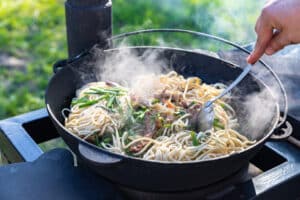
When lagman is plate of noodles with toppings, the topping portion is referred to as “vadzha” (ваджа). Vadzha refers to something resembling a very thick stew that is not meant to be eaten on its own, but rather added to broth or other ingredients.
Many Central Asian recipes, including for lagman, call for potatoes. Despite the fact that the potato was only introduced to Central Asia in the mid-nineteenth century, they have quickly become a staple of most cuisines there.
The most convenient tool for cooking lagman is a good, thick cauldron (known as a “казан” or “kazan” in most Turkic and Slavic languages). A wok or cast-iron frying pan can also be used.
A Note About The Noodles
The best lagman features homemade, hand-stretched noodles. Of course, today, store-bought noodles are far more common, but making these noodles isn’t too hard, even if it requires some patience. Make sure the dough is as elastic as possible by using high quality pasta flour. For each kilogram, you’ll need 300 milliliters of water, 2 eggs, one teaspoon of vinegar, and salt to taste. Pasta recipes will often skip the vinegar, but it is precisely that which will give your dough the extra plasticity and allow you to stretch it without too much exertion.
Pour the flour into a deep bowl, make a well, gently pour in the beaten eggs, and a little warm water. Carefully fold the mixture into dough, and add extra flour to thicken it if need be (but don’t add too much or the dough will be too thick to stretch!). Then aggressively knead the dough until it’s homogeneous and stretchy. The longer and stronger you knead the dough, the more elastic and adhesive it becomes, making it easier for you to stretch it later. Make the dough into a ball, wrap it in cellophane, and put in a cool place for thirty minutes to an hour to rest.
Next, divide the dough into pieces and roll it into thick strands. Carefully coat each strand with vegetable oil and let them sit for 10-15 minutes. After that, start to stretch the dough by rolling it tightly between your palms and the table, trying not to break it. Do this to each strip twice and then stretch it with your hands. The pasta should remain on the table, which makes it easy to roll and keeps it from breaking. If it doesn’t turn out like you want, keep trying. Fresh noodles are an unforgettable and tasty experience!
Cook the pasta immediately. Fill a deep pot with water, add salt and bring to a boil. Without lowering the heat, put the pasta into the water for 3-5 minutes. Don’t stir the pasta, otherwise it will clump. Then, put it into a strainer and rinse with cold water. Put the pasta in a deep dish and coat it with vegetable oil so it won’t stick together.
If you do use store bought noodles, use regular spaghetti. This has the right texture to eat with a thick dish like lagman.
Great Lagman Recipes
Давай приготовим!
| Традиционный лагман | Traditional Lagmann |
| Для соуса:
– 500 граммов баранины Для лапши: – 1 кг муки Приготовление лапши:
Приготовление соуса:
|
Ingredients for the sauce:
– 500 grams roast lamb For the pasta: – 1 kg of flour Making pasta:
Making Sauce:
|
| Овощной (вегетарианский) лагман | Vegetarian Лагман |
| Ингредиенты
– 1-2 ст. л. растительного масла Приготовление Вегетарианцы могут приготовить вкусный и ароматный лагман совершенно без мяса.
|
Ingredients
– 1-2 tablespoons oil Preparation Vegetarians can prepare delightfully delicious and aromatic лагман perfectly without meat.
|
Our Favorite Lagman Videos
Celebrity Uzbek chef demonstrates how to make Uzbek lagman in Russian.
This chef takes you through the whole process from start to finish. The Russian-language narration goes pretty slowly, which might be annoying to some, but probably welcomed by folks looking to practice their listening skills. The music is also an entertaining plus.
Presented in English and Russian (with subtitles), this is a profile of a Dungan family from Kazakhstan who came to open a Dungan restaurant in New York City. It covers their culture and history fairly extensively and makes great connections between the food and culture.
You Might Also Like

Knots of Culture: Central Asia’s Carpet Weaving Heritage
Central Asia’s rich tradition of carpet weaving reflects the region’s history, culture, and identity. From the ancient nomads of the Pazyryk Valley to the artisans of Kyrgyz yurts and the urban weavers of Samarkand, carpets have long served both practical and symbolic functions. Their materials, techniques, and motifs reflect centuries of interaction between nomadic and […]

The Talking Kyrgyz Phrasebook
The Talking Phrasebook Series presents useful phrases and words in side-by-side translation and with audio files specifically geared to help students work on listening skills and pronunciation. Below, you will find several useful phrases and words. To the left is the English and to the above right is an English transliteration of the Kyrgyz translation. […]
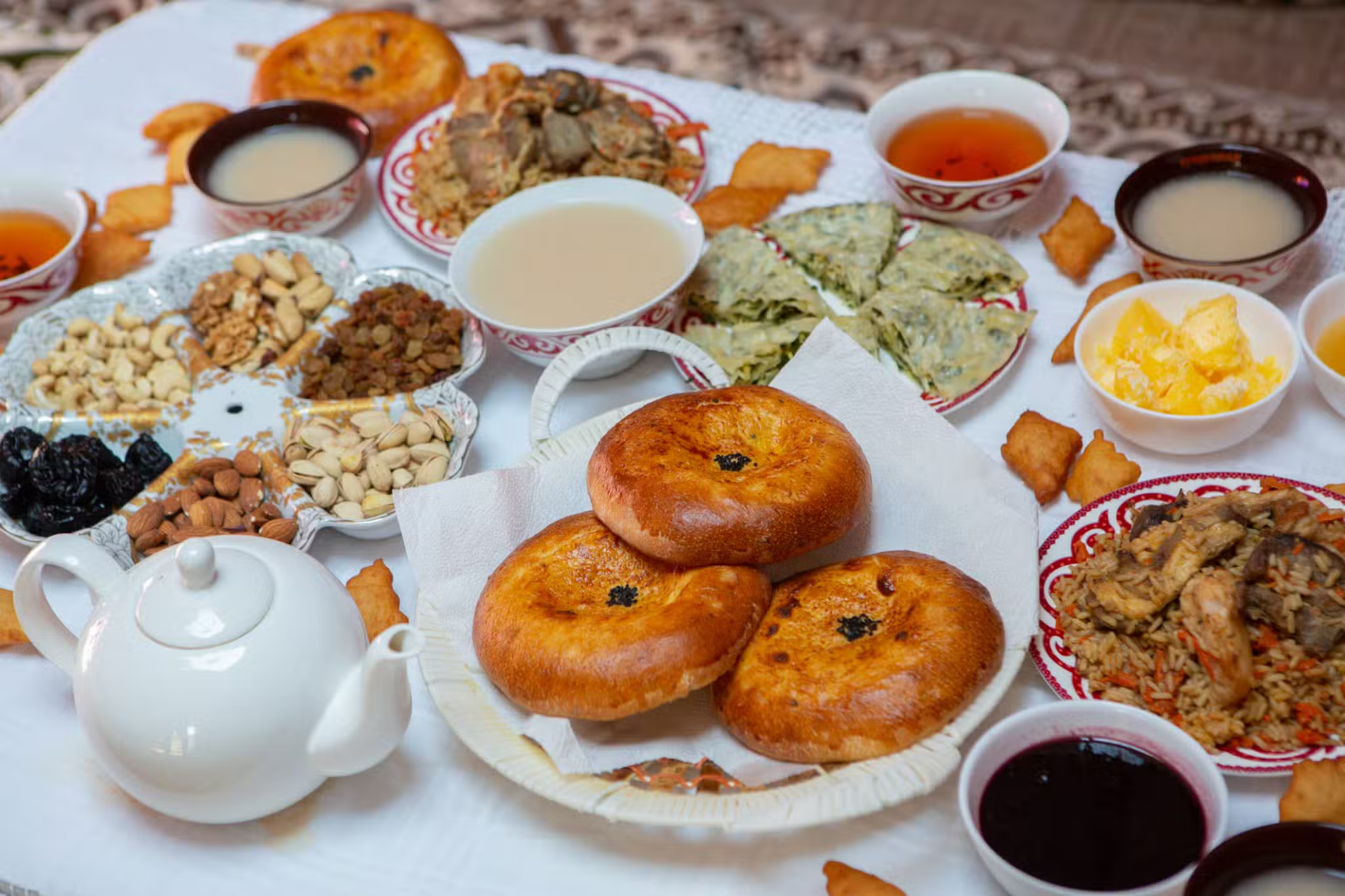
The Kyrgyz Food Dictionary
Kyrgyz cuisine reflects the country’s heritage of pastoral nomadism. Life was spent moving livestock from pasture to pasture and living in collapsible, transportable yurts. The livestock themselves were the primary, sustainable food source. Everything else was either gathered from the land or traded for. The Kyrgyz did not engage in intensive settled agriculture until forced […]

Manas and the Manaschi: Foundations of the Kyrgyz Soul
There are few essential things to know about Kyrgyzstan. One of these is the country’s folkloric hero, Manas. You’ll find nearly everything in Krygyzstan is named after him: the main airport, national parks, major streets in nearly every city and town, and even karate clubs and movie theaters, not to mention the statues of him […]

Kyrgyz Identity: Understanding the Kyrgyz National Narrative
What created Kyrgyz national identity? This is a complex question and one that is personal for each Kyrgyz person. This resource will focus on presenting one element of this identity – the Kyrgyz national narrative. Who are the national heroes and what are the pivotal events that they learned about in school? What are the […]

